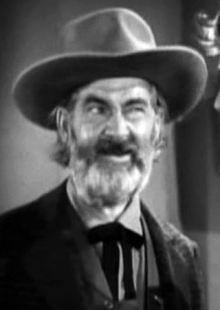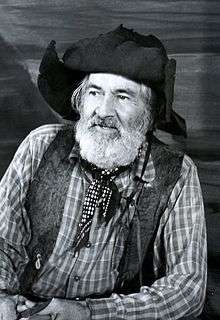George "Gabby" Hayes
| George "Gabby" Hayes | |
|---|---|
 Hayes in The Carson City Kid, 1940 | |
| Born |
George Francis Hayes May 7, 1885 Stannards, New York, USA |
| Died |
February 9, 1969 (aged 83) Burbank, California, USA |
| Occupation | Actor |
| Years active | 1902–56 |
| Spouse(s) | Olive E. Ireland (m. 1914–57) |
George Francis "Gabby" Hayes (May 7, 1885 – February 9, 1969) was an American radio, film, and television actor. He was best known for his numerous appearances in Western films as the colorful sidekick of the leading man.
Early years
Hayes was born the third of seven children in his father's hotel in Stannards, New York, a hamlet just outside Wellsville, New York. (Hayes always gave Wellsville as his birthplace, but legally he was born in Stannards).[1][2] He was the son of Elizabeth Morrison and Clark Hayes. His mother's brother was George F. Morrison, vice president of General Electric. Hayes did not come from a cowboy background; he did not know how to ride a horse until he was in his forties and had to learn for film roles.
His father, Clark Hayes, operated the Hayes Hotel in Stannards and was also involved in oil production. George Hayes grew up in Stannards and attended Stannards School.[2] He played semiprofessional baseball while in high school. He ran away from home in 1902, at 17, joined a stock company, apparently traveled for a time with a circus, and became a successful vaudevillian.
Hayes married Olive E. Ireland, the daughter of a New Jersey glass finisher, on March 4, 1914. She joined him in vaudeville, performing under the name Dorothy Earle (not to be confused with film actress and writer Dorothy Earle). Hayes had become so successful that by 1928, at age 43, he was able to retire to a home on Long Island in Baldwin, New York. He lost all his savings the next year in the 1929 stock-market crash. Earle persuaded Hayes to try his luck in films, and the couple moved to Los Angeles. They remained together until her death on July 5, 1957. The couple had no children.
Film career
After his move to Los Angeles, according to later interviews, Hayes had a chance meeting with the producer Trem Carr, who liked his look and gave him 30 roles over the next six years. In his early career, Hayes was cast in a variety of roles, including villains, and occasionally played two roles in a single film. He found a niche in the growing genre of Western films, many of which were series with recurring characters. Ironically, Hayes would admit he had never been a big fan of Westerns.
Hayes, in real life an intelligent, well-groomed and articulate man, was often cast as a grizzled codger who uttered phrases such as "consarn it", "yer durn tootin'", "dadgummit", "durn persnickety female", and "young whippersnapper."
From 1935 to 1939, Hayes played the part of Windy Halliday, the sidekick to Hopalong Cassidy (played by William Boyd). In 1939, Hayes left Paramount Pictures in a dispute over his salary and moved to Republic Pictures. Paramount held the rights to the name Windy Halliday, so the nickname Gabby was created for Hayes's character. As Gabby Whitaker, he appeared in more than 40 films between 1939 and 1946, usually with Roy Rogers (44 times), but also with Gene Autry (7) and Wild Bill Elliott (14), often working under the directorship of Joseph Kane (34).

Hayes was also repeatedly cast as a sidekick of the Western stars Randolph Scott (six times) and John Wayne (15 times, some as straight or villainous characters). Hayes played Wayne's sidekick in Raoul Walsh's Dark Command (1940), which featured Roy Rogers in a supporting role. Hayes became a popular performer and consistently appeared among the 10 favorite actors in polls taken of moviegoers of the period. He appeared in either one or both the Motion Picture Herald and Boxoffice Magazine lists of Top Ten Money-Making Western Stars for 12 straight years and a 13th time in 1954, four years after his last film.
The Western film genre declined in the late 1940s, and Hayes made his last film appearance in The Cariboo Trail (1950). He moved to television and hosted The Gabby Hayes Show, a Western series, from 1950 to 1954 on NBC and, in a new version in 1956, on ABC. He introduced the show, often while whittling on a piece of wood, and would sometimes throw in a tall tale. Halfway through the show, he would say something else, and at the end of the show, also, but he did not appear as an active character in the stories. When the series ended, Hayes retired from show business. He lent his name to a comic book series and to a children's summer camp in New York.
Death
Following his wife's death on July 5, 1957, Hayes lived in and managed a 10-unit apartment building he owned in North Hollywood, California. In early 1969, he entered Saint Joseph Hospital in Burbank, California, for treatment of cardiovascular disease. He died there on February 9, 1969, at the age of 83. He was interred in the Forest Lawn–Hollywood Hills Cemetery in Los Angeles.
Honors
Hayes has Two stars on the Hollywood Walk of Fame commemorate Hayes's work in the entertainment industry, one for his contribution to radio, at 6427 Hollywood Boulevard, and one for his contribution to the television, at 1724 Vine Street. In 2000, he was posthumously inducted into the Western Performers Hall of Fame at the National Cowboy and Western Heritage Museum in Oklahoma City, Oklahoma.
Popular culture
Homage was paid to Hayes in a different way in the 1974 satirical Western Blazing Saddles. The actor and director Jack Starrett, credited as Claude Ennis Starrett, Jr., played a Hayes-like character. In keeping with a running joke in the movie, the character is called Gabby Johnson. After Johnson delivers a rousing, though partially unintelligible speech to the townspeople, David Huddleston's character stands up to say, "Now, who can argue with that?!", and proclaims it "authentic frontier gibberish."[3]
In the animated film Toy Story 2, the character Stinky Pete the Prospector, voiced by Kelsey Grammer, is modeled after Hayes.[4] In the film's fictional universe, he is a toy version of a character on the marionette television western Woody's Roundup, where he is a colorful comic relief character. In contrast, the toy is intelligent and well spoken, a reference to Hayes's contrasting real-life and film personas.
Hayes inspired the Doppio Rhum character in Captain Miki, an Italian comic series. Hayes has also been portrayed in impressions by Fred LaBour (Too Slim), during Riders in the Sky performances. In a Mighty Carson Art Players sketch on The Tonight Show, Johnny Carson impersonated Gabby Hayes in a sketch with Roy Rogers. This sketch has appeared on Carson's syndicated series Carson's Comedy Classics, which features highlights from his years as The Tonight Show host.
Hayes was mentioned in The Simpsons episode "Radioactive Man", in which Milhouse becomes Radioactive Man's sidekick, Fallout Boy; the director of the film comments that Milhouse is "going to be big, Gabby Hayes big!"
Every year in early July, from 1983 through 1989, "Gabby Hayes Days" were celebrated in Wellsville, New York. The event featured a street sale, square dancing, and Hayes look-alike contests for adults and children. This celebration was eventually merged into the mid-July Wellsville Balloon Rally and gradually disappeared. A street is also named after him in Wellsville, Gabby Hayes Lane.[2][5][6]
The famous Manhattan restaurant Danny's Hideaway, at 151 East 45th Street, called one of its main dining areas the Gabby Hayes Room in honor of the friendship between the owner, Dante "Danny" Stradella, and Hayes.[7]
Comic appearances
- Gabby Hayes Adventure Comics 1 (1953, Toby Press)
- Gabby Hayes Western 1–59 (1948–1957, Fawcett Publications)
- Gabby Hayes Western 50–111 (1951–1955, L. Miller black-and-white reprints of Fawcett Comics)
- Gabby Hayes Mini Comics, 5 issues (1951, Quaker Oats giveaway)
Partial filmography
- Big News (1929)
- Dirigible (1931), uncredited
- The Stolen Jools (1931), short film
- Breed of the Border (1933)
- Riders of Destiny (1933), the first of a series of John Wayne Lone Star Westerns
- The Lucky Texan (1934)
- West of the Divide (1934)
- Blue Steel (1934)
- Randy Rides Alone (1934)
- The Star Packer (1934)
- The Lawless Frontier (1934)
- The Man From Utah (1934)
- 'Neath the Arizona Skies (1934), uncredited
- In Old Santa Fe (1934), Gene Autry's screen debut
- The Lost City (1935), serial
- Texas Terror (1935)
- Rainbow Valley (1935)
- Smokey Smith (1935)
- Tombstone Terror (1935)
- The Headline Woman (1935)
- The Lawless Nineties (1936)
- Mr. Deeds Goes to Town (1936), uncredited
- The Texas Rangers (1936)
- Valiant Is the Word for Carrie (1936)
- Hopalong Cassidy Returns (1936) as Windy Halliday
- The Plainsman (1936)
- Trail Dust (1936) as Windy
- Borderland (1937) as Windy Halliday
- Rustlers' Valley (1937) as Windy Halliday
- Hopalong Rides Again (1937) as Windy Halliday
- Heart of Arizona (1938) as Windy Halliday
- Bar 20 Justice (1938) as Windy Halliday
- Pride of the West (1938) as Windy Halliday
- The Frontiersmen (1938) as Windy Halliday
- Sunset Trail (1938) as Windy Halliday
- Silver on the Sage (1939) as Windy Halliday
- Renegade Trail (1939) as Windy Halliday
- Days of Jesse James (1939) as Gabby Whittaker
- Let Freedom Ring (1939) as George F. Hayes
- Dark Command (1940)
- Wagons Westward (1940)
- The Carson City Kid (1940) as Gabby Whittaker
- The Border Legion (1940)
- Robin Hood of the Pecos (1941)
- Sheriff of Tombstone (1941)
- Red River Valley (1941)
- Romance on the Range (1942)
- Sons of the Pioneers (1942)
- Calling Wild Bill Elliott (1943)
- In Old Oklahoma (1943)
- Mojave Firebrand (1944)
- Hidden Valley Outlaws (1944)
- Tall in the Saddle (1944)
- The Big Bonanza (1944)
- Don't Fence Me In (1945)
- Along the Navajo Trail (1945) as Gabby Whittaker
- My Pal Trigger (1946)
- Heldorado (1946)
- Wyoming (1947)
- Trail Street (1947)
- Albuquerque (1948)
- Return of the Bad Men (1948)
- The Cariboo Trail (1950)
References
- ↑ Wellsville Daily Reporter, 17 September 1966
- 1 2 3 "Photo Gallery: Town of Willing, NY.". p. 1. Retrieved 27 April 2011.
- ↑ "Authentic Frontier Gibberish". YouTube.
- ↑ "The Toys Are Back in Town". SFgate. 24 November 1999. Retrieved 14 April 2016.
- ↑ Wellsvilleballoonrally.com
- ↑ Ancestry.com
- ↑ Purecowboy.us
External links
| Wikimedia Commons has media related to George 'Gabby' Hayes. |
- George "Gabby" Hayes at the Internet Movie Database
- George "Gabby" Hayes at the TCM Movie Database

- Amctv.com article on Hayes and other Western Sidekicks